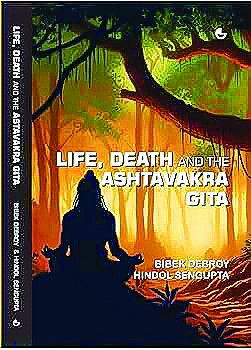BENGALURU: That a book, a poem, a discourse, whose history and tradition go back thousands of years, when transmission was through oral means, can touch someone’s life in a profound way, making space for understanding, acceptance, and letting go, makes us pause, even stop, and think.
“Life, Death and the Ashtavakra Gita” is a combination of a translation of the text by Bibek Debroy, accompanied by an intensely personal reflection by Hindol Sengupta on the Gita and his experiences.
A Gita means a song. There are some Gitas in Hinduism that are more famous than others. The most well-known Gita is, of course, Krishna’s divine song and discourse, delivered to Arjuna on the battlefield of Kurukshetra—the Bhagavat Gita. The Mahabharata itself has several Gitas, and Bibek Debroy recently wrote a book with translations of 25 such Gitas (Sacred Songs: The Mahabharata’s Many Gitas, pub. Rupa, 2023).
Eighty-six shlokas in three chapters from the Teertha-yatra upa parva (in the Aranyaka Parva) of the Mahabharata tell us the most we know about the sage. The Ashtavakra Gita is a dialogue between Sage Ashtavakra and King Janaka. The Ashtavakra Gita itself is however not a part of the Mahabharata. There is a fleeting mention of the sage in the Valmiki Ramayana, a mention in Adhyatma Ramayana, and a little, much later, in Bhavabhuti’s Uttararamacharita. The Ashtavakra Gita itself is short—285 shlokas in 20 chapters, and is much shorter than the Bhagavat Gita, which has 700 shlokas over 18 chapters. Unlike the Bhagavat Gita, the Ashtavakra Gita has seen relatively fewer translations and commentaries. Swami Nityaswarupananda in 1940, John Richards in 1994, Rajiv Kapur in 2011-14, Bart Marshall in 2005, and by Swami Chinmayananda in 2014 are some.
Advaita Vedanta posits that the atman and the Brahman are the same, they are not distinct, they are not two. The Ashtavakra Gita is considered one of the most distilled advocations of Advaita Vedanta. As Bibek Debroy writes in the Introduction, “It is a direct and undiluted exposition of advaita (non-dual) Vedanta. To quote, in 2-2, Ashtavakra says, ‘Just as I alone provide illumination to the body, I do that to the universe too. Therefore, either the entire universe belongs to me, or nothing does.’ In 2-5, the sage says, ‘When one reflects on it, a piece of cloth is nothing but strands of thread. In that way, when one reflects about it, the universe is nothing other than the atman.’ The path to moksha (liberation) lies not in a self-sacrificing pursuit of liberation, or even a surrender to a supreme deity, for that itself is an expression of an embedded desire—‘It is extraordinary that though he desires moksha, he is terrified of moksha.’” (3-9).
That a book, a poem, a discourse, whose history and tradition go back thousands of years, when transmission was through oral means, can touch someone’s life in a profound way, making space for understanding, acceptance, and letting go, makes us pause, even stop, and think.
What is personal is perceived more acutely than the abstract. Hindol’s reminiscence melds the Ashtavakra Gita with his experiences during Covid. The pandemic was a traumatic time for many, when many lost their loved ones, but it also became, willy-nilly, a time for introspection for some. Locked in the confines of their homes, spending the entire day with family became the catalyst for confrontations, venting of pent-up emotions, airing of grievances and peeves, and perhaps catharsis, ultimately. Writing about it is not easy, having to turn a writer’s gaze inwards, and then turn that mirror, so to say, outwards, baring locked up thoughts and feelings about the self for all to see, and judge. For many, judgment precedes, and often precludes, empathy. Hindol’s account does not hold back, or perhaps it does, but what he writes about hits home, hard, at times: “…having led a relatively impoverished childhood, my adult life acquisitions had been piled up in the hope of wiping out memories of old indignities.” (page 145)
Life, experience, and the passage of time can, at times, lead to both insights and an appreciation for one’s parents in a way that only life and time can bring. One starts to think, as Hindol did, “…that I did not know much about the dreams and aspirations of my parents beyond those that had been projected on me.” Being middle-class in India usually meant parents sacrificed, depending on their circumstances and nature, for the sake of their children. For many, it was an uncomplicated expression of the internalization of dharma. The realization, later in life, of what those decisions meant, is not an easy, or kind, one. Resentment at sacrifices made that were not explicitly asked for, dismay at the impossibility of paying back, in any form, what was given, can be difficult. Hindol writes about all that, and more. “The histories took a bit of time to emerge.” “I mourned my lack of knowledge about the man before me; I was fearful that time for me to learn was running out.”
Woven in this very personal account, interleaved with his readings of the Ashtavakra Gita, Hindol also travels through the Kathopanishad (any discourse on life, death, and moksha is incomplete without Nachiketa’s discourse with Yama), Chandogya Upanishad (which contains the discourse between Sage Uddalaka Aruni and his son, Swetaketu), Kabir, and even the legendary classical singer, Kumar Gandharva.
The simplicity and directness of the Ashtavakra Gita does not lend itself to a boilerplate shibboleths, however. Hindol writes, “I wanted concrete instructions, a to-do list, tasks, goals. But the Ashtavakra Gita would not oblige…”
“Life, Death and the Ashtavakra Gita” is a welcome addition to the as-yet small corpus of works on this text. The experiment of combining a literal translation by Bibek Debroy with a reminiscence by Hindol Sengupta is mostly a successful one. The addition of the original Sanskrit shlokas is an added, and welcome, bonus. Spend a weekend reading it, and perhaps a lifetime internalizing it.
Disclaimer: Views expressed are personal.

